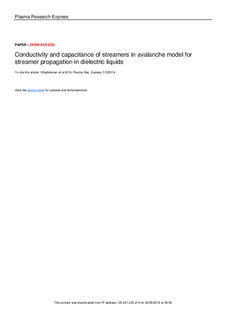| dc.contributor.author | Madshaven, Inge | |
| dc.contributor.author | Hestad, Øystein Leif Gurandsrud | |
| dc.contributor.author | Unge, Mikael | |
| dc.contributor.author | Hjortstam, Olof | |
| dc.contributor.author | Åstrand, Per-Olof | |
| dc.date.accessioned | 2019-10-01T05:51:10Z | |
| dc.date.available | 2019-10-01T05:51:10Z | |
| dc.date.created | 2019-09-03T14:49:16Z | |
| dc.date.issued | 2019 | |
| dc.identifier.citation | Plasma Research Express. 2019, 1 (3), . | nb_NO |
| dc.identifier.issn | 2516-1067 | |
| dc.identifier.uri | http://hdl.handle.net/11250/2619454 | |
| dc.description.abstract | Propagation of positive streamers in dielectric liquids, modeled by the electron avalanche mechanism, is simulated in a needle–plane gap. The streamer is modeled as an RC-circuit where the channel is a resistor and the extremities of the streamer have a capacitance towards the plane. The addition of the RC-model introduces a time constant to the propagation model. Increase in capacitance as a streamer branch propagates reduces its potential, while conduction through the streamer channel increases its potential, as a function of the time constant of the RC-system. Streamer branching also increases the capacitance and decreases the potential of the branches. If the electric field within the streamer channel exceeds a threshold, a breakdown occurs in the channel, and the potential of the streamer is equalized with the needle electrode. This is interpreted as a re-illumination. According to this model, a low conductive streamer branch can propagate some distance before its potential is reduced to below the propagation threshold, and then the RC time constant controls the streamer propagation speed. Channel breakdowns, or re-illuminations, are less frequent when the channels are conductive and more frequent for more branched streamers. | nb_NO |
| dc.language.iso | eng | nb_NO |
| dc.publisher | Institute of Physics, IOP Science | nb_NO |
| dc.rights | Navngivelse 4.0 Internasjonal | * |
| dc.rights.uri | http://creativecommons.org/licenses/by/4.0/deed.no | * |
| dc.title | Conductivity and capacitance of streamers in avalanche model for streamer propagation in dielectric liquids | nb_NO |
| dc.type | Journal article | nb_NO |
| dc.type | Peer reviewed | nb_NO |
| dc.description.version | publishedVersion | nb_NO |
| dc.source.volume | 1 | nb_NO |
| dc.source.journal | Plasma Research Express | nb_NO |
| dc.source.issue | 3 | nb_NO |
| dc.identifier.doi | 10.1088/2516-1067/ab4072 | |
| dc.identifier.cristin | 1721083 | |
| dc.relation.project | Norges forskningsråd: 228850 | nb_NO |
| dc.description.localcode | Open Access. Original content from this work may be used under the terms of the Creative Commons Attribution 3.0 licence. Any further distribution of this work must maintain attribution to the author(s) and the title of the work, journal citation and DOI. CC-BY | nb_NO |
| cristin.unitcode | 194,66,25,0 | |
| cristin.unitname | Institutt for kjemi | |
| cristin.ispublished | true | |
| cristin.fulltext | original | |
| cristin.qualitycode | 1 | |

